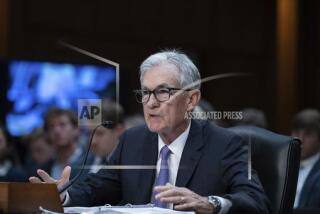Fed Committee Favored Lower Interest Rates : Recovery: Notes show policy-makers agreed to maintain ‘bias’ toward easier credit if needed.
- Share via
WASHINGTON — Federal Reserve policy-makers decided at a mid-November meeting to maintain a policy leaning toward lower interest rates if the economy began to sputter, according to minutes released on Thursday.
Members of the Federal Open Market Committee reviewed information that “suggested that economic activity had been expanding at a moderate pace,” the minutes said. At the same time, wage and price data suggested “a continuing trend toward lower inflation.”
As a result, all but three of the 12 members agreed to maintain a policy that would include “some bias” toward easing interest rates if needed. As it turned out, the Fed did not act.
The majority included Fed Chairman Alan Greenspan and governors Wayne D. Angell, Edward W. Kelley Jr., Lawrence B. Lindsey, David W. Mullins Jr. and Susan M. Phillips, and Fed regional bank presidents E. Gerald Corrigan, Thomas H. Hoenig and Richard F. Syron.
Fed Gov. John P. LaWare and regional President Thomas C. Melzer disagreed, saying the bias toward lower interest rates was unnecessary because of the strengthening economy.
Regional President Jerry L. Jordan dissented because of a desire for faster growth in the money supply.
The FOMC adopted the current policy leaning toward lower interest rates, if needed, in midsummer when the economy entered a mild slump.
It voted to continue that policy during meetings in August and October, although it agreed to a stronger, “marked bias” toward easing at the latter meeting.
The FOMC met again this week, but its meetings are closed to the public.
More to Read
Inside the business of entertainment
The Wide Shot brings you news, analysis and insights on everything from streaming wars to production — and what it all means for the future.
You may occasionally receive promotional content from the Los Angeles Times.










